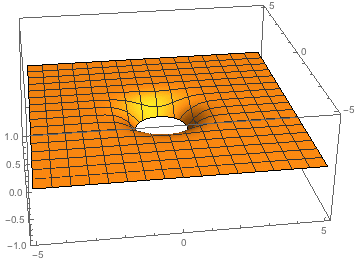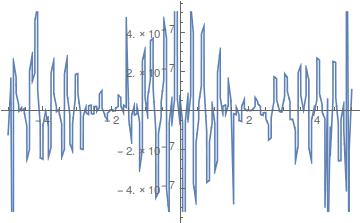The problem I would like to solve involves diffusion in the following region
reg = ImplicitRegion[-5 <= x <= 5 && -5 <= y <= 5 && x^2 + y^2 >= 1^2, {x, y}];
RegionPlot[reg, AspectRatio -> Automatic]

Additionally, there is an interaction potential $v$ acting in this region:
v = Function[{x, y}, -E^(-x^2 - y^2)];
Plot3D[v[x, y], {x, -5, 5}, {y, -5, 5}, RegionFunction -> Function[{x, y, z}, x^2 + y^2 > 1^2], PlotRange -> {-1, 1}, PlotPoints -> 50]

Physically, I would like to model 2D diffusion confined to this region, in the presence of the biasing potential given by $v$. So what I need to do is solve the PDE $\vec{\nabla} \cdot \left[\vec{\nabla}u(x,y) + u(x,y) \vec{\nabla}v(x,y)\right] = 0$ subject to the boundary conditions
$u(x,-5) = 1$
$u(x,5) =0$
to impose an overall flux, and with zero-flux boundary conditions at the boundary where $x^2 + y^2 = 1$, (as well as on the sides where $x = \pm 5$). So I proceed as follows in Mathematica (10.0.0):
op = Div[Grad[u[x, y], {x, y}] + u[x, y] Grad[v[x, y], {x, y}],{x, y}];
bc = {DirichletCondition[u[x, y] == 1, y == -5],DirichletCondition[u[x, y] == 0, y == 5]};
Note that I did not specify boundary conditions for the circular boundary, nor for the sides $x = \pm 5$, because according to the NDSolve/NeumannValue documentation, these should default to zero-flux boundary conditions.
sol = NDSolve[{op == 0, bc}, u, {x, y} \[Element] reg, Method -> {"FiniteElement","MeshOptions" -> {MaxCellMeasure -> 0.005}}]
The solution looks like this:
Plot3D[Evaluate[u[x, y] /. sol], {x, y} \[Element] reg, PlotRange -> All, AxesLabel -> {"x", "y"}]

Now, this is not quite what I expected, for the following reason:if the PDE is solved correctly, with zero-flux boundary conditions, then the flux into the box (at y = -5) should equal the flux out of the box (at y = 5). You can sort of tell that this is not the case from the plot above, but plotting the normal derivative at the boundaries $y = \pm 5$ makes it clear:
Plot[{Evaluate[(Derivative[0, 1][u][x, 5] + u[x, 5] Derivative[0, 1][v][x, 5]) /.sol],
Evaluate[(Derivative[0, 1][u][x, -5] + u[x, -5] Derivative[0, 1][v][x, -5]) /. sol]}, {x, -5, 5}, PlotRange -> {-0.2, 0}]

Integrating these will give the flux in and the flux out. Clearly the flux in is not equal to the flux out. Since I have checked to make sure that the PDE $\vec{\nabla} \cdot \left[\vec{\nabla}u(x,y) + u(x,y) \vec{\nabla}v(x,y)\right] = 0$ is obeyed in the interior of the region, it seems that I am not correctly setting the Neumann boundary condition at the circular boundary $x^2 + y^2 = 1$. The boundary condition that I want is
$\left[\vec{\nabla}u(x,y) + u(x,y) \vec{\nabla}v(x,y)\right] \cdot \vec{n} = 0$
but I believe that the boundary condition that I'm getting is simply
$\left[\vec{\nabla}u(x,y)\right] \cdot \vec{n} = 0$
How can I impose the correct boundary condition? Have I misunderstood the documentation, which seems to say that my desired boundary condition is the default?


op = Div[Grad[u[x, y], {x, y}] + Grad[v[x, y], {x, y}] u[x, y], {x, y}] - Div[Grad[v[x, y], {x, y}], {x, y}] u[x, y]and see if this solves your problem. (I know the equation looks strange),if this is the case, I have an idea what is going on. $\endgroup$op = 2*E^(-x^2 - y^2)*y*Derivative[0, 1][u][x, y] + Derivative[0, 2][u][x, y] + 2*E^(-x^2 - y^2)*x*Derivative[1, 0][u][x, y] + Derivative[2, 0][u][x, y]$\endgroup$opdiffers from myopby a term- Div[Grad[v[x, y], {x, y}], {x, y}] u[x, y]. $\endgroup$